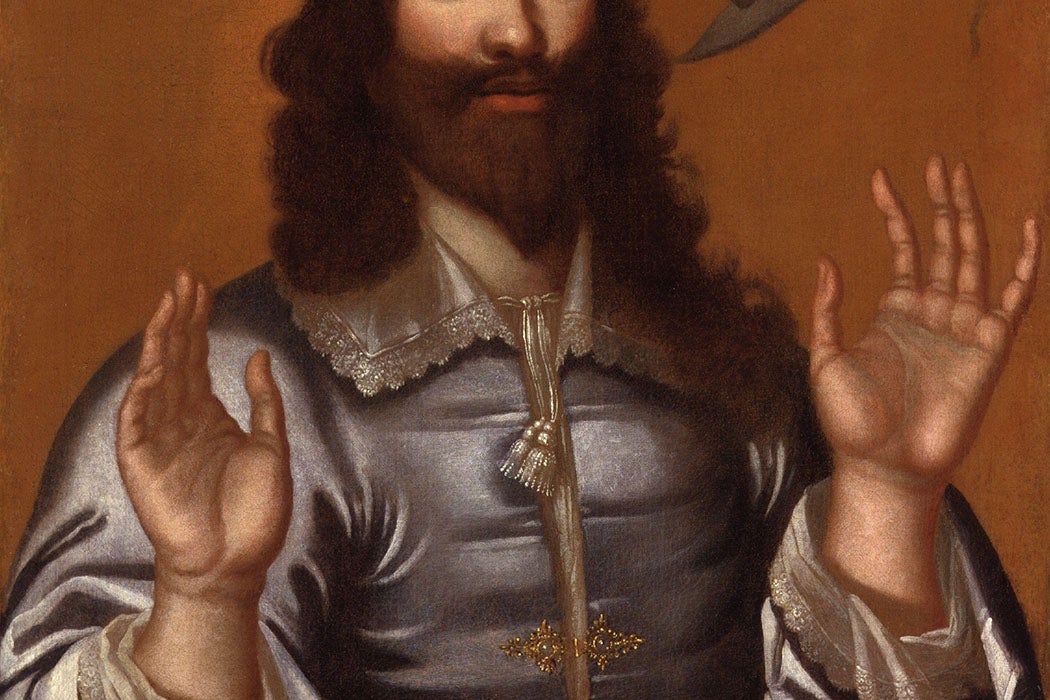In 1649, the year King Charles I was beheaded for treason, a handkerchief soaked in the dead king’s blood cured a woman of blindness. Another handkerchief, belonging to a Mrs. Hunsdon, and dipped likewise in his majesty’s blood, was reported to have performed no less than twenty cures. Everywhere, it seemed, droplets of royal blood had become like holy relics, performing miracles. The physician John Browne, in his book on the subject, paints a grisly scene of devotees gathered around the execution block, handkerchiefs ready to mop up the king’s blood, “and applying thereof to their Scrophulous Swellings… they found immediate ease, and present relief.”
Another story recounts how, in the king’s final days, he was sought out by a man suffering from sores thought to be caused by scrofula, a form of tuberculosis that causes unsightly, cauliflower-like swellings on either side of the neck. Although the king was surrounded by guards, and could not reach the sick man to touch him, he called out a blessing and prayed for the man’s health. When the man returned home, he took a drink from a bottle of medicinal waters that he had been using, unsuccessfully, to treat his disease.
Want more stories like this one?
But something strange had begun to happen to the bottle: ulcers and sores were budding from its sides, just like those on the man’s face. As the bottle grew more and more swollen, the man grew healthier and healthier. Soon, he was entirely cured. Then, one day he showed a guest the magic bottle. The guest picked off one of the scabs, and, immediately, the man’s throat began to hurt once more.
These stories reflect a debate that was raging at the time about the nature of sovereignty: Did kings rule by God’s appointment, or by the consent of the ruled? King Charles had asserted his divine right to rule by dissolving Parliament. For this, he was later executed, and the monarchy was transformed into a republic (for a time). For those who believed that English kings ruled by God’s appointment, the execution of King Charles I was a shocking scandal. The accounts of miraculous cures from the king’s blood or blessing, circulating in pamphlets, were a demonstration of God’s favor toward the king. Imagine how many more people could have been healed, one pamphleteer mourned, had Charles lived to bless all the sick and unfortunate of England with his regal hands.
For centuries in England, the ability to heal scrofula had been considered the divinely-granted power of kings. For this reason, the disease was called “the king’s evil,” the evil the king had the power to heal. Edward the Confessor, who ruled from 1042 to 1066, was the first English king to cure the king’s evil with his touch. He anointed a sick woman’s throat with water and made the sign of the cross above it. A wonder followed: “those diseased parts (morbus) that had been treated by the smearing of the king softened and separated from the skin; and, with the pressure of the hand, worms together with pus and blood came out of various holes. Again the good king kneeded with his holy hand and drew out the pus.” The woman was healed.
Over the successive centuries, and successive monarchies, the ritual of the monarch’s healing touch grew from occasional individual healings to vast spectacles. These grand occasions, formalized with an official liturgy, served to prop up the monarchy. The ceremonies showed that the monarchs ruled by the will of God, as divine power worked through the monarch’s anointed hands. The king would touch each sufferer’s swollen throat, make the sign of the cross, and hang a gold coin inscribed with the image of an angel around each neck. Often there were hundreds of supplicants for the king to heal. The mass healings were so popular that eventually sufferers were required to produce a certificate verifying that they had never received the monarch’s touch before.
Not every king was a proponent of the ceremony. William of Orange was famous for his reluctance to perform healings, and indeed seemed to think the whole idea was superstitious nonsense. The one time he was prevailed upon to touch a sufferer from the king’s evil, he prayed to God “to Heal the Patient, and grant him more Wisdom at the same time.”
At times, kings had to work to maintain their monopoly on the power to heal the king’s evil. In some cases, pretenders to the throne claimed to have the healing touch, sure proof of the legitimacy of their rule. More common were those bit players, folk healers, and small-time magicians who claimed to have special healing powers of one kind or another. Seventh sons, for instance, were sometimes believed to have the ability to cure the king’s evil. During King Charles I’s reign, the king’s council ordered an investigation into a five-year-old seventh son who held popular weekly healings, but let the child off with a warning.
Another folkloric tradition held that the touch of a dead man’s hand, usually an executed convict hanging from a gibbet, had the power to cure goiters, wens, and other such swellings. Sufferers would be lifted up to let the fingers of the hanged man’s hand brush against them. The blood of an executed man, too, was believed to be a powerful medicine. Perhaps this is why King Charles I’s blood was so potent, and why handkerchiefs soaked in it became like the relics of saints. In the figure of the condemned king, both cures are combined. In one person, he is at once divine ruler and executed criminal.







